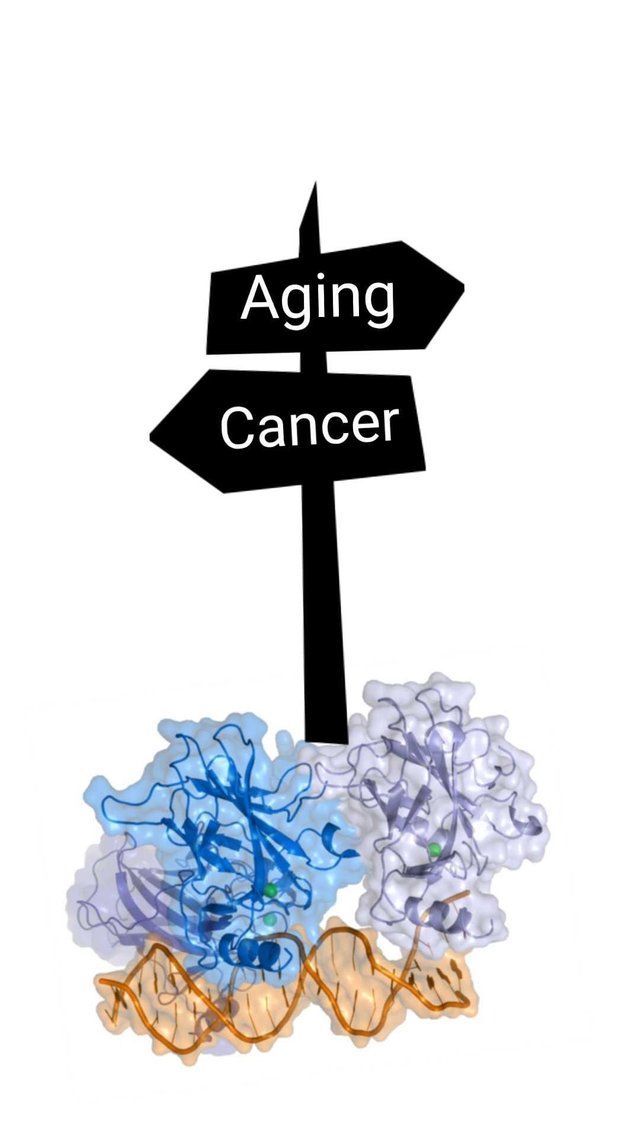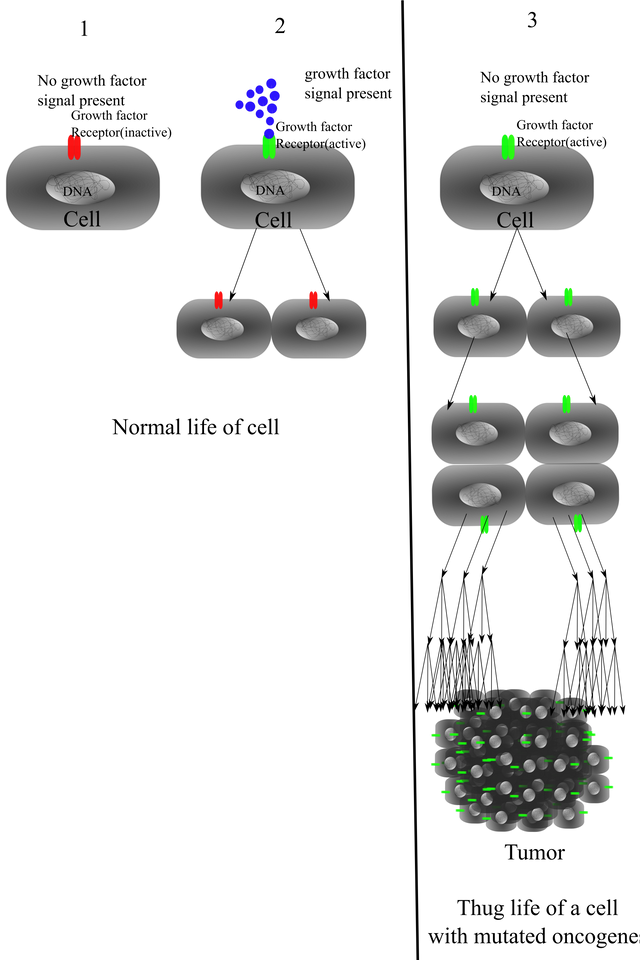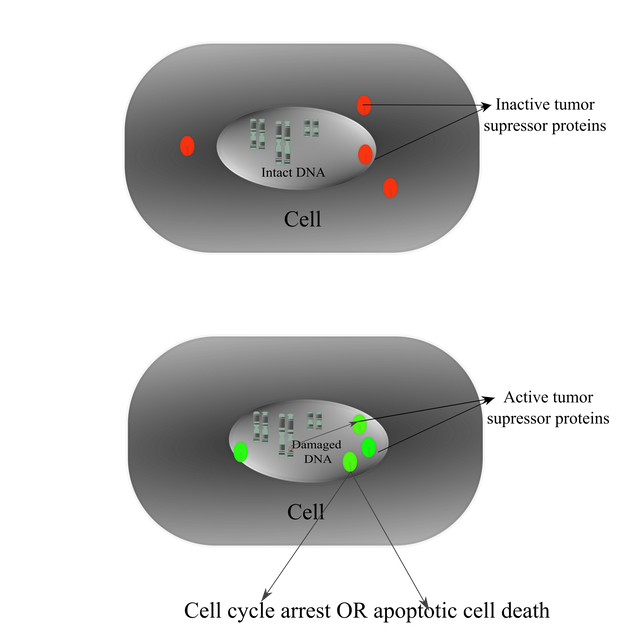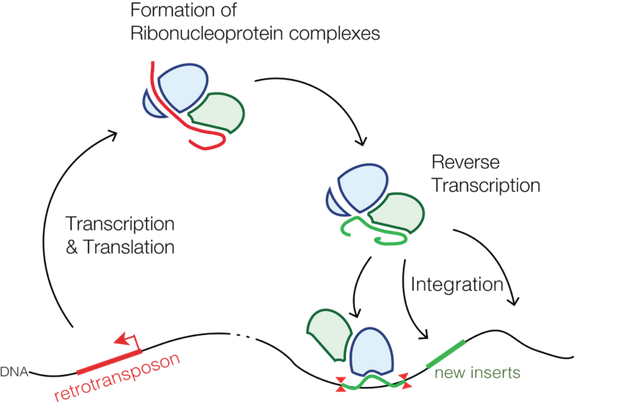Paradoxical solution of Peto's paradox - Elephants at crossroads of cancer, ageing and toxicity.
They say that the answers leads to more questions. They are not wrong, ask any PhD student, seriously! But today we are going to spare the grad students and going to ask this question to the elephants?

p53 protein bound to DNA(bottom), Author Thomas Splettstoesser | CC BY-SA 3.0
The crossroad sign(Top), Image by kmicican | CC0
A couple of weeks ago, @scienceangel shared a post asking a question, that why don't elephants get cancer?. The crux of the matter is, that if you assume that every cell in your body has finite probability of becoming a cancer cell per year - then more cells you have and/or more number of years you live, the higher should be the incidence of cancer. However, no such correlation was observed in nature. Elephants for instance, who have 100 times more cells than us and live longer than us, do not develop cancer, at least not as frequently as we do. Neither do blue whales. This is called Peto's paradox(see Peto, 1977).(Do read @scienceangel's post for detailed description).
However, a series of papers recently discussed the possible solution to this. I am not going to bore you with stuff you might have already read about cancer and Peto's paradox, but for what I want to say some briefing might be necessary.
Etiology of cancer

Created by @scienceblocks
As you read this, about a billion cells in your body are multiplying. In fact, the continuous turnover of cells in your body is so high, that in 3-4 weeks, you literally have new skin on your body. However, both multiplication and death of cells in many of your organs, and not just skin, is regulated. They are maintained in a delicate balance of homeostasis. If this balance is perturbed you die. For instance if a cell in your body goes rouge and go on its own way, dividing uncontrollably, you get cancer(wonder why don't they call it cgtow - cells going their own way).
Anyway, in order to avoid this from happening there are multiple check points in your cells. The first checkpoint is to only divide when there is a signal to to divide. However, in unfortunate cases there happens a mutation which creates a fake signal. For instance a mutated growth factor receptor can falsely signal the cells to divide consistently. These genes that promote the division of cells, and whose constitutively active mutations leads to cancer, are called 'oncogenes'.

By @scienceblocks
Chromosome image by gsagri04 used and modified from openclipart | CC0 1.0
However, checkpoints are not limited to this signal. A lot of shit can go down even in a normally dividing cell. For instance cells need to copy their DNA before they divide into two. However, while synthesising this DNA they may encounter an error in the DNA. For instance some broken DNA fragment. If the cell and it's progeny wants to live in harmony with other cells in the body, they better have a mechanism in place to stop, and first fix that DNA damage. This is where another set of genes called tumor suppressors come into play.
DNA damage can occur in the cells for many reasons - exposure to UV, carcinogens in tobacco smoke, virus, oxidative stress, or just spontaneous hydrolysis. Be it whatever may if the cells have damaged DNA, the best option is to either put a break on their division or kill them. This is what tumor suppressors do. For instance if a protein called p53, in your cells detects damaged DNA, it either causes cell cycle arrest and senescence or it instructs the cell to commit suicide via apoptosis. If it doesn't, then cells will just accumulate mutations and one of that mutation will cause cancer(among other maladies).
The Grand solution for large animals.

cigarette by Bru-nO
speech bubble by NicholasJudy567
CC0
Since, tumor suppressors can suppress the rouge damaged cells from initiating cancer, you may think that having a lot of these guys at your service, would help you evade cancer. Well, this is what they proposed in elephants(Abegglen et al., 2015). While in humans we have 1 copy or 2 alleles of TP53 gene in each cell, elephants have 20 copies or 40 alleles. Moreover, as if 20 copies of genes making p53 were not enough, their cells have activated a dead gene, called LIF6(Vazquez et al., 2018). What does it do? On sensing DNA damage it goes to mitochondria of the cell and releases the suicide pill, locked in the powerhouse of the cells. Cell dies! (You should read this blog by @scisteem, which beautifully describes the LIF6 study)
Interesting right? And it all makes sense to you. Wait for it! Just hang in there with me.
Accelerated ageing and toxicity of tumor suppressors - The problem with the solution.
Before we even look at the evidence, just think about it. Having too many tumor suppressors may provide a buffering mechanism - that is, if one tumor suppressor gets random mutation, then you will still have a back up plan. Nonetheless, if too many tumor suppressors are active in cell, it will lead to toxicity. If you keep killing your cells, even for a feeble hint of DNA damage, or a noisy signal, you may soon deplete your stem cell pool.
And in support of this, it has been shown that over-expression of TP53 gene in mice, leads to reduced size, small kidneys, loss of fertility and even accelerated aging(Ou and Schumacher, 2018, Tyner et al., 2002). This made me wonder - why are elephants not aging at a super high speed, or showing any other phenotype that were seen in p53 overexpressing mice.
The solution to the paradox, looked like a paradox in itself! What the hell is going on in elephants?
Resolution of second order paradox
As far as LIF6 study goes, the authors show that this resurrected gene in elephant cells is expressed at very low basal levels. It requires activation of p53 protein to get expressed at high levels. So it aids p53 in killing the cells and but it is not toxic in absence of p53 activation.
But 20 copies of p53, that is crazy. I kept thinking that there has to be a buffering mechanism that is keeping it in check. I thought of a few possibilities -
maybe the extra copies are supressed, by either methylation or by histone modification, and do not get expressed.
maybe the stem cell pool in elephants is way too abundant and do not get exhausted so soon.
maybe the proteins that keep p53 in check, such as MDM2 are in abundance in elephants, as well.
maybe p53 have other functional roles in elephant cells which acts as a sink for extra copies.
Atleast, the few media reports I read on this study kept me confused, and I decided to read the literature.
The jumping genes and parts of TP53 gene

Source | Author: Mariuswalter | CC BY-SA 4.0
The 2015 paper that described 20 copies of p53 in elephant cells, did mention that 1 copy of this gene is the conventional one, while the other 19 copies are retrogenes. Now, the thing with retrogenes is that they are formed by reterotranaposition.
Think of it this way - retroviruses like HIV today are nothing new. They have existed since dawn of life. The retroviruses are RNA viruses that copy paste their genome on DNA of cells they infect. Over the course of evolution some of these viruses lost their ability to make the animal they are infecting sick. But their genome became permanently incorporated in cells of animals, including ours. They usually don't do much, but sometimes they jump around from one place in our DNA to another. Hence, jumping genes.
Something similar happened with elephant. However, this time jumping gene happened to have a copy of elephant's original p53 gene, within it. Over the course of evolution, it jumped around creating 19 retrogenes in African elephant and about 15 in Asian.
The thing with retrogenes however, is that they may not be complete copy of the parent gene. It can be bits and pieces of it. And this is true for p53 retrogenes as well. Which should make you ask two questions -
whether these genes are even expressed? (Well because when the jumping gene carried it along, it probably did not carry the gene's promoter or its enhancer.)
How many of those genes that are still expressed are still functional? And how many have the same function as the parent gene.
These questions were addressed in detail by Sulak et al., in 2016. They found that at least 6 of them did not have coding potential. So you are now left with 13 retrogenes of TP53. Moreover, those that were expressed were not full length p53. The incomplete p53 proteins that these genes expressed lacked the potential to enter the nucleus of the cells like full length p53 does. Moreover, for one of the retrogenes, whose product still entered the nucleus, was incapable of initiating gene expression like conventional p53 would had.
So, no these extra 19 copies were not multiplying the function of one copy by 20. However, what they seem to be doing in elephant cells is making conventional p53 signalling more robust, kind of increasing the signal to noise ratio of DNA damage. Do read the 2016 paper, for more details on mechanism of increasing robustness.
What probably happened, was that when the jumping gene copied the bits and pieces of TP53 in elephant's ancestor's genome, those genes that were fully functional, would have been selected against. I mean how would toxic dose help the animal survive, right? Those that were non-functional or not expressed lied dormant or were lost to further mutations. However, a few of them that were expressed and were semi-functional, and provided the advantage against cancer, without being toxic, were selected for.
However I am still not sure about the size of stem cell niches in elephants, but I think it could be larger in proportion as well. Also, it would be interesting to explore the immune response to tumor cells in elephants.
References
Peto's paradox by Scienceangel
Signing off
@scienceblocks


Great article!
It is criminally underrated.
Congratulations! Your post has been selected as a daily Steemit truffle! It is listed on rank 7 of all contributions awarded today. You can find the TOP DAILY TRUFFLE PICKS HERE.
I upvoted your contribution because to my mind your post is at least 14 SBD worth and should receive 202 votes. It's now up to the lovely Steemit community to make this come true.
I am
TrufflePig, an Artificial Intelligence Bot that helps minnows and content curators using Machine Learning. If you are curious how I select content, you can find an explanation here!Have a nice day and sincerely yours,

TrufflePigIt's almost the same thing with naked-mole rats.
But even they get cancer sometimes
Thank you for the article
Resteemed your article. This article was resteemed because you are part of the New Steemians project. You can learn more about it here: https://steemit.com/introduceyourself/@gaman/new-steemians-project-launch
Very interesting stuff , but this articles is criminally underrated.